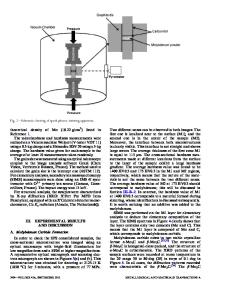Spark Plasma Sintering of Yttria-Stabilized Zirconia/Titanium Nitride Composites
- PDF / 761,275 Bytes
- 5 Pages / 612 x 792 pts (letter) Page_size
- 96 Downloads / 319 Views
Spark Plasma Sintering of Yttria-Stabilized Zirconia/Titanium Nitride Composites Paulo S. M. Silva and Fabio C. Fonseca Nuclear and Energy Research Institute – IPEN, São Paulo, SP, 05508-000, Brazil. ABSTRACT Composites of 8 mol% yttria-stabilized zirconia (YSZ) and titanium nitride (TiN) were obtained by mechanical mixing of commercial powders. High-density samples of (1-x) YSZ / x TiN, with x = 0, 25, 50, and 75 wt.%, were obtained by spark plasma sintering (SPS) at 1450 °C for 5 min. Surface contamination with carbon from the SPS was eliminated by diamond sawing of parallel surfaces. X-rays diffraction analyses showed that samples are composed by a mixture of the initial phases, without appreciable reaction as inferred from calculated lattice parameters. dc 4-probe electrical measurements in the 100-850°C under showed that samples have a metallic behavior, indicating that the percolation threshold was attained for the sample with the lowest content of the TiN (x=25 wt.%), which corresponds to ~27 vol.%. INTRODUCTION High-performance materials are required for different applications at high-temperatures such as for replacing conventional metal parts on special structural and electronic devices and for manufacturing complex shape ceramic components by electric discharge machining (EDM) [1]. Among different types of ceramics, composites having oxides and covalent phases have been investigated for applications requiring unique mechanical and electrical properties [2-7]. Previous studies have studied the properties of composites having partially-stabilized zirconia and a covalent phase, such as TiC, TiN, and TiB2, aiming at enhanced mechanical properties [2]. However, relatively less attention has been given to the electrical properties of such zirconiabased composites [2-7]. More recently, yttria-stabilized zirconia (YSZ) and WC composites have been investigated as solid oxide fuel cell aiming at carbon-resistant anode [7]. TiN has been pointed out as a high melting temperature (2950 °C) material with good conductivity and high resistance to corrosion and oxidation [3]. Nevertheless, sintering of such composites can be a hard task. Therefore, to fabricate composites with high density and fast processing, with reduced temperatures to avoid undesired reactions and microstructural evolution, requires advanced sintering techniques [2-6,8]. In the present study we have investigated the properties of YSZ-TiN composites fabricated by spark plasma sintering (SPS) aiming at good electrical properties at high temperatures. EXPERIMENTAL Starting materials were 8 mol% yttria-stabilized zirconia (Tosoh, Japan) and TiN (SigmaAldrich). Batches of 5 g of powders were mixed in a ball mill using ethanol and partiallystabilized zirconia grinding media (4 mm diameter) for 80 min to obtain (1-x) YSZ / x TiN samples, with x = 0, 25, 50, and 75 wt.% (YSZ / x TiN). After ball mill, the slurry was dried under constant magnetic mixing, followed by homogenization of the dry powder in agate mortar. Cylindrical pellets were sintered by pulsed el
Data Loading...











